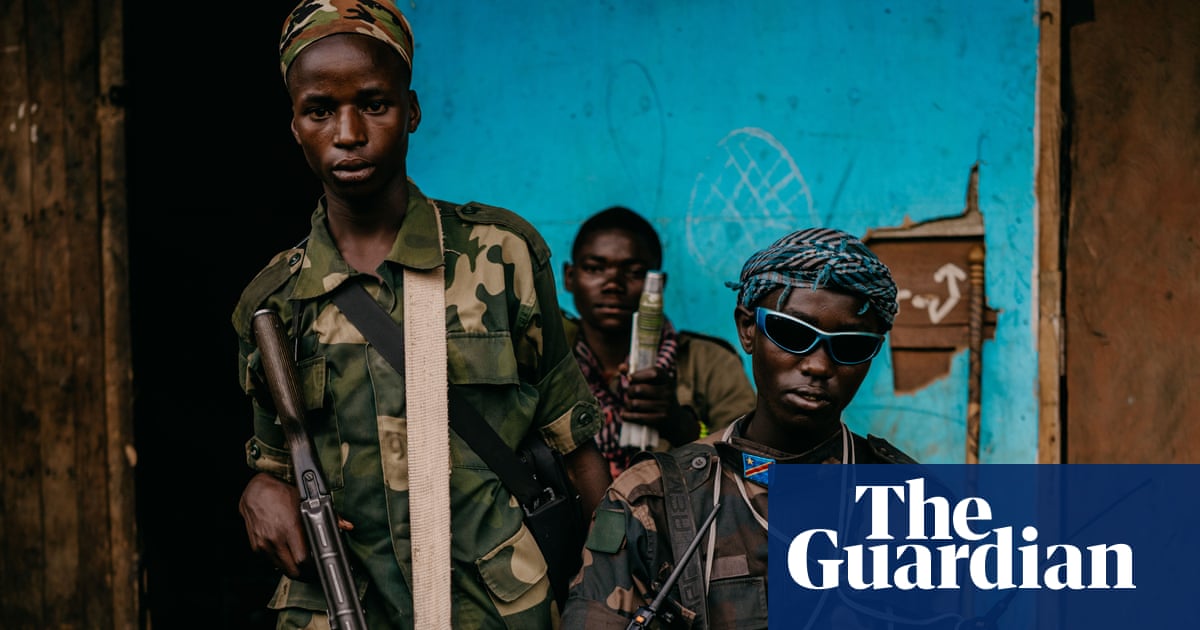In late 2021, Rwandan-backed rebels known as the M23 started raiding villages in the eastern regions of the Democratic Republic of Congo. At first, they stuck to remote areas, then they moved into more heavily populated towns. More and more people lost their homes as the chaos spread across the region. The DRC’s army then staged a fightback. Instead of only using official forces, it rearmed and remobilised local militia groups called Mai Mai, who have fought on various sides throughout the country’s decades of conflict.
Last October, I accompanied some of these government-backed militia as they tried to wrest back control of villages along the DRC’s eastern edge. One morning, we set off on the road to Kitchanga, a small town a few hundred kilometres from the Rwandan border. The Mai Mai were beginning their counterattack and they were enjoying an early breakthrough. They recaptured a handful of villages that had been lost to M23 rebels. There was a sense of momentum. As we stopped for a break in one of these recaptured towns, there was a huge militia unit taking a breather. In those moments of calm, I try to chat with people, usually by offering them a cigarette, before asking if I can take their photograph.
Some of the older militia tend to play a character when the camera is pointed at them. They hold their gun that little bit higher, sling their rocket-launcher over their shoulder, that sort of thing. In one instance, a guy pointed his rifle at the lens – until his commander saw him and smacked the gun down. In retrospect, that’s probably the closest I’ve ever come to being shot.
These fighters were teenagers. They sat apart from some of the older guys. They were chilling, waiting until the march restarted, and agreed to let me take this photograph. Sometimes I find myself only selecting the pictures where people aren’t aware of the camera – photos with, say, the composition of an old painting. But these kids are staring at me, attempting to pose, but with that adolescent awkwardness they can’t quite shake. The kid in the headscarf looks like he’s slightly embarrassed to be showing off. It crystallised just how lost and vulnerable they are.
I think the strangest thing for me personally was the sense of deja vu in taking this image. One of my first jobs in the DRC was with Save the Children five years ago. They hired me to photograph one of their programmes offering counselling, retraining and support to child soldiers. Back then, there was a sense of hope that the cycle of violence might break, even if only for some in the region. And then here I was, five years later, with a new cycle of violence sucking in vulnerable young men and boys.
The militia group these boys fought with was meant to be the vanguard of what was going to be a more concerted counteroffensive run by the Congolese army. I saw a convoy of special forces driving up to take control of operations. Then, within two or three days of this photo, the M23 counterattacked and retook all of this ground. The militia fled. The army were slaughtered. And the whole process repeated.
I’ve been in the DRC for long enough now that I have begun to recognise some of the same soldiers in these armed groups. I wouldn’t say I know them, nor that I understand the conflict. Some guys are forced to fight. Some want to. It’s as much about community as it is opportunity. But for the kids it’s different. Lots of them are sent off to the front, drugged out of their minds, sniffing glue, or drunk on cheap spirits.
The conflict has changed since this photo was taken. Some of the militia groups have faded into irrelevance, because the fighting has become so much heavier – a lot of it now is artillery, heavy-duty equipment, drones, and so on. But a lot of the villages have been burned to the ground, whether by the M23 fighters or the government-backed militia. As we were driving back from Kitchanga, night fell, and you could see different encampments in the villages ruined in the fighting. It was a vision of hell.
There are now more than seven million displaced people in the DRC from various conflicts – and over a million from the M23 conflict alone. I think I keep photographing here because I’m trying to capture something about conflict more generally: the sense that it deprives people of any chance of defining their own histories.
Hugh Kinsella Cunningham has been awarded the ICRC Humanitarian Golden Visa for his photojournalism on civilians in eastern DRC. His work is at the Visa pour l’Image festival in Perpignan, France, 31 August to 15 September.
Hugh Kinsella Cunningham’s CV
Born: London, 1994.
Trained: Self-taught.
Influences: “Jamie Hawkesworth. Most of his work is in fashion, but there’s a lightness of touch I try to emulate.”
High point: “Either winning the Amnesty International award this year, or winning first prize in the Sony awards last year, which meant I got a whole room to myself for exhibiting my work from Congo.”
Low point: “Visiting the hotels and the refugee camps at the heart of this British migrant deal story. It felt hopeless.”
Top tip: “Always do that one extra thing.”

